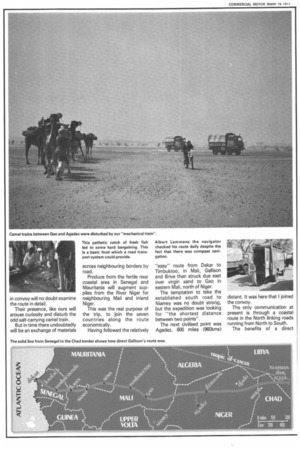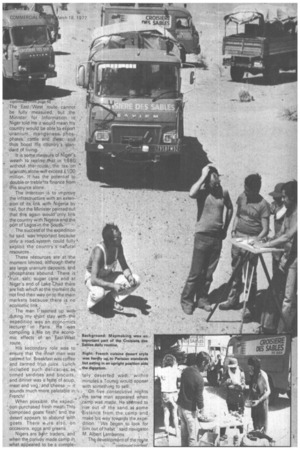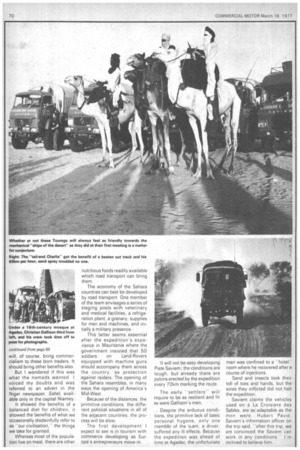111111111.1" Oiening UP fl African trail...a
Page 69

Page 70

Page 71

Page 72

If you've noticed an error in this article please click here to report it so we can fix it.
THE EXPEDITION to find a trans-Africa route from East to West (CM, March 4), sponsored by a number of French interests is over.
The movement which began on December 27 took all of 10 weeks to cover 7000km, most of it over virgin sand.
The 12 men, their equipment and personal kit were transported in seven Saviems specially, but only marginally, modified for desert conditions.
The measurement of wear on the vehicles will be carried out at Saviem's engineering establishment in France. The wear on the personnel will be measured by their physicians.
The extent of human wear and tear is anybody's guess, but from my relatively short sojourn with them I think it could be considerable. The results will interest vehicle designers and engineers.
Christian Gallison, the leader is a very fit 40-year-old; his deputy Constantin Brive is a young looking 65-year-old. The comparison between their respective physical conditions after this trip will make interesting reading for the medical profession.
The log of the entire trip, which Gallison has to compile will interest geographers, cart ographers, archaeologists, geologists and armchair explorers. But these are marginal benefits which the arduous days and nights in the desert will produce.
Much more important to the people along the new trans Sahara route is how will they benefit? What will it mean to the seven nations in national terms, what will it mean to the one and half million people who live along the route?
In the short term, the effects of the new route will hardly be felt. A few exploratory vehicles in convoy will no doubt examine the route in detail.
Their presence, like ours will arouse curiosity and disturb the odd salt-carrying camel train.
But in time there undoubtedly will be an exchange of materials across neighbouring borders by road.
Produce from the fertile near coastal area in Senegal and Mauritania will augment supplies from the River Niger for neighbouring Mali and inland Niger.
This was the real purpose of the trip, to join the seven countries along the route economically.
Having followed the relatively "easy" route from Dakar to Timbuktoo, in Mali, Gallison and Brive then struck due east over virgin sand to Gao in eastern Mali, north of Niger.
The temptation to take the established south road to Niamey was no doubt strong, but the expedition was looking for "the shortest distance between two points".
The next civilised point was Agadez, 600 miles (960kms)
The East /West route: cannot be fully measured, . but the Minister for Information in 'Niger told me it would mean his country would be able to export uranium, manganesephos. phates, cattle and Meat, and thus boost his country's standard of living.
. It is some measure of Niger's weath to realise that in 1980 without the route, the tax on uraniarri alone will exceed £1 00 million. It has the potential to double or treble-its finance from this source alone.
The intention is to improve the 'infrastructure with an extension of its link with Nigeria by • rail, but the Minister pointed out that this again would'only link the country with Nigeria and the pOrt of Lagos in the South. • • • The success'of the expedition he said, was important because only a road-system could fully: exploit the country's nafural resources. .
These resources are at -the moment limited, although there are large uranium deposits, and phosphates abound. There is *fruit, salt, sugar cane and at Niger's end of Lake Chad there are fish which at the moment do not find their way on to the main markets because there is no economic link,.
The man I • teamed up with during my short stay with-the expedition was an econOmics lecturer in Paris. He • was compiling a file on the economic effects • of an East-West • route. . • '
His Secondary role was to ensure that the inner man was catered for. Breakfast was coffee • and canned fruit juice. Lunch included such delicacies., as' tinned sardines and biscuits, and dinner was a feast of-soup. meat and veg; and cheese — it sounds much Tnore palatable in French!
When possible, the expedition purchased fresh meat: This comprised goats flesh: and the desert appears to abound with goats. There wure also, on occasions, eggs and greens. .
Nigers are bcirr traders, and when the convoy made camp in, what appeared to be a comple tely deserted wadi, within minutes a Toureg would appear with something to sell
On five consecutive nights the same man appeared when camp was made. He seemed to rise out of the sand at some -distance from the camp and make his way towards the expedition. -We began to look for him out of habitsaid navigator M. Albert Lambenns
The development of the rovte will, of course, bring commercialism to these born traders. It should bring other benefits also.
But I wondered if this was what the nomads wanted. I voiced my doubts and was referred to an advert in the Niger newspaper, Sahel, available only in the capital Niamey.
It showed the benefits of a balanced diet for children, it showed the benefits of what we occasionally disdainfully refer to as ''our civilisation," the things we take for granted.
Whereas most of the population live on meal, there are other nutritious foods readily available which road transport can bring them.
The economy of the Sahara countries can best be developed by road transport. One member of the team envisages a series of staging posts with veterinary and medical facilities, a refrigeration plant, a granary, supplies for men and machines, and initially a military presence.
This latter seems essential after the expedition's experience in Mauritania where the government insisted that 50 soldiers on Land-Rovers equipped with machine guns should accompany them across the country, as protection against raiders. The opening of the Sahara resembles, in many ways the opening of America's Mid-West.
Because of the distances, the primitive conditions, the different political situations in all of the adjacent countries, the process will be slow.
The first development I expect to see is in tourism with commerce developing as Europe's entrepreneurs move in. It will not be easy developing Piste Saviem; the conditions are tough, but already there are pylons erected by the expedition every 70km marking the route.
The early —settlers— will require to be as resilient and fit as were Gallison's men.
. Despite the arduous conditions, the primitive lack of basic personal hygene, only one rnembtir of the tbarn, a driver, suffered any ill effects. Because the expedition was ahead of time at Agadez, the unfortunate man was confined to a ''hotel" room where he recovered after a course of injections.
Sand and insects took their toll of toes and hands, but the sores they inflicted did not halt the expedition.
Saviem claims the vehicles used on a La Croisiere des Sables, are as adaptable as the men were. Hubert Pavie, Saviem's information officer on the trip said, "after this trip, we are convinced the Saviem can work in any conditions." I'm inclined to believe him.




























































































































